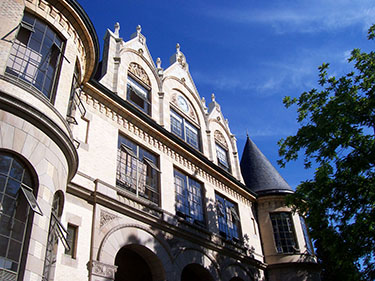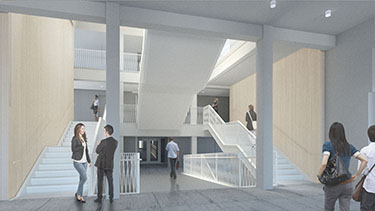|
Subscribe / Renew |
|
|
Contact Us |
|
| ► Subscribe to our Free Weekly Newsletter | |
| home | Welcome, sign in or click here to subscribe. | login |
Construction
| |
 |
November 19, 2015
How crews used BIM to cope with unwelcome surprises at Denny Hall
PCS Structural Solutions

Stauffer
|
The University of Washington is an institution that is proud of its history. Its pride endures with the restoration and modernization of many of its original buildings, including the significant renovation now occurring at Denny Hall.
The entire design team’s use of building-information modeling (BIM) and digital scanning has been one significant key to the success of this challenging project.
In the late 1880s, the city of Seattle had grown to over 50,000 people. Due to that growth, as well as the success of the programs offered by the University of Washington, a nearly 350-acre plat of land was acquired near Union Bay. The campus remains at this location today, surrounded by buildings rich in history.
The very first facility built on the new campus was Denny Hall. Designed by Charles Saunders, construction began in the summer of 1894, with classes first held in the fall of 1895.
It was positioned with a view of Lake Washington and the Cascades in the distance. Located up the hillside at the northwest corner of the campus, Denny Hall would remain a focal point for the growing campus in the decades to come.
As the first building on campus it needed to provide space for many different uses, including laboratories, presentation rooms, a museum, offices and a grand assembly hall. A prominent structure, Denny Hall was intended to last for generations.
Lost glory
Nearly 120 years after its doors were first opened, the university elected to perform a major renovation and restoration to the historic building.
The exterior has changed little over the years — Charles Saunders would likely be pleased to see how much of the exterior retains his original design. The brick, stone, and terra cotta has been well-maintained over the decades, and very few exterior modifications have occurred.
However, and perhaps unfortunately, the interior has been dramatically altered. The original construction consisted of wood-framed floors and roofs supported by exterior and interior brick walls and cast-iron columns.
Large fireplaces were located throughout the building, and the grand staircase, which connected the basement level to the fourth floor, was ornately ringed with cast-iron handrails. The auditorium was a stately, two-story space with main-level and balcony seating and a proscenium opening at the stage.
Due to campus growth and significantly changing needs, the building underwent a major renovation in the 1950s. While the roof framing was saved, all of the wood-framed floors and supporting structures were removed, and replaced with concrete floors supported by steel columns and concrete walls. The grand two-story auditorium was lost, converted into three minimal-height office levels.
The new interior configuration added much-needed space for additional classrooms and offices. Some areas, such as the classrooms at the curved entry archway, remained a regal space that was reminiscent of the original construction.
However, in many cases the magnificence of the interior was lost. Vertical circulation was now limited to enclosed concrete stair cores. In an attempt to gain as many rooms as possible, many of the office spaces were cramped and lacked windows.
A problem discovered
In 2007, the university hired Hacker Architects to lead a team charged with designing a substantial modernization to Denny Hall. A large portion of that task was to upgrade the interior systems and improve the seismic performance. Additionally, a central, full-height staircase with a large overhead skylight was reintroduced to the building, recapturing some of the hall’s original grandeur.
One monumental challenge became apparent during review of the existing documentation. A building-information model was developed that showed, in high detail, the relationship of the existing structural elements. The model revealed that the roof configuration shown in the original 1890s drawings didn’t align with the 1950s renovation drawings, and neither layout correlated with on-site investigations.
It was determined that an internal digital scan, also known as a point cloud, would be valuable to the development of the model and subsequent design solutions.
BNBuilders, acting as the general contractor/construction manager on the project, performed an interior scan of the attic space, and later of the entire building. The PCS Structural Solutions team then imported the scan into the structural model, which was originally developed from the existing drawings.
It became clear that many liberties had been taken during the building’s original construction and subsequent renovations. In several locations the columns were actually built several feet away from where the construction drawings had indicated, and secondary support braces were missing entirely.
The scan also showed that some of the roof slopes didn’t match the existing documents, which pushed beams and joists to elevations that didn’t match the existing drawings either.
Updating the model
In the past, many of these circumstances would not have been discovered until construction was underway.
Modifications to the design and layout of the systems would occur on a case-by-case, and often frantic, basis. However, the entire Denny Hall design team, as well as the contractor, embraced the use of BIM.
Existing drawings and the point cloud were used in unison to accurately model the existing structural system. The new structural elements were then added to the model, and framing that was to be demolished was left in the model so that it could be referenced during construction sequencing.
Using the updated structural model, BNBuilders led their team of contractors in accurately modeling all of the new systems being installed in the building before demolition of the structure had even begun. The team incrementally worked through the building, carefully coordinating, adjusting and re-coordinating the structure, ducting and piping to ensure an accurate virtual layout, so that in-the-field surprises were kept to a minimum.
Thanks to the use of 21st-century technology by a design and construction team committed to accuracy and efficiency, the University of Washington’s historic Denny Hall will remain a cornerstone of the Seattle campus for another century to come.
Craig Stauffer has 22 years of experience in education design and is Managing Principal and President of PCS Structural Solutions, which has offices in Seattle and Tacoma.
Other Stories:
- No detail is too small for UW nanoengineering lab
- Classroom of the future takes shape at WSU— and it's round
- New UW dorms revive a long-lost urban pathway
- UW, WSU find ways to do more with less
- WSU’s Paccar building houses 5 R&D labs
- WSU’s wine center aims to train next generation of winemakers
- UW: Top 10 capital projects
- WSU: Top 10 capital projects




